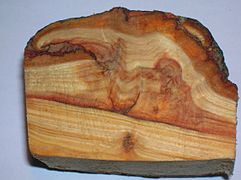Burl
Burl
Jump to navigation
Jump to search
This article includes a list of references, but its sources remain unclear because it has insufficient inline citations. (June 2011) (Learn how and when to remove this template message) |

Burls on a tree trunk in Norfolk, England.
A burl (American English) or bur or burr (UK English) is a tree growth in which the grain has grown in a deformed manner. It is commonly found in the form of a rounded outgrowth on a tree trunk or branch that is filled with small knots from dormant buds.
Contents
1 Description
2 Use
3 Poaching
4 Varieties
4.1 Amboyna burls
5 Gallery
6 See also
7 References
8 Further reading
9 External links
Description[edit]

Large burl on a spruce tree at Denali State Park, Alaska
This section does not cite any sources. (May 2014) (Learn how and when to remove this template message) |
A burl results from a tree undergoing some form of stress. It may be caused by an injury, virus or fungus. Most burls grow beneath the ground, attached to the roots as a type of malignancy that is generally not discovered until the tree dies or falls over. Such burls sometimes appear as groups of bulbous protrusions connected by a system of rope-like roots. Almost all burl wood is covered by bark, even if it is underground. Insect infestation and certain types of mold infestation are the most common causes of this condition.
In some tree species, burls can grow to great size. The largest, at 26 ft (7.9 m), occur in coast redwoods (Sequoia sempervirens) and can encircle the entire trunk; when moisture is present, these burls can grow new redwood trees. The world's second-largest burls can be found in Port McNeill, British Columbia. One of the largest burls known was found around 1984 in the small town of Tamworth, New South Wales. It stands 6.4 ft (2.0 m) tall, with an odd shape resembling a trombone. In January 2009, this burl was controversially removed from its original location, and relocated to a public school in the central New South Wales city of Dubbo.
Use[edit]

A burled spruce log carved for use as a railing with built-in seats on a log cabin
Burls yield a very peculiar and highly figured wood, prized for its beauty and rarity. It is sought after by furniture makers, artists, and wood sculptors. There are a number of well-known types of burls (each from a particular species); these are highly valued and sliced into veneers for furniture, inlay in doors, picture frames, household objects, automobile interior paneling and trim, musical instruments, and woodturning. The famous birdseye maple of the sugar maple (Acer saccharum) superficially resembles the wood of a burl but is something else entirely. Burl wood is very hard to work with hand tools or on a lathe because its grain is twisted and interlocked, causing it to chip and shatter unpredictably. This "wild grain" makes burl wood extremely dense and resistant to splitting, which made it valued for bowls, mallets, mauls and "beetles" or "beadles" for hammering chisels and driving wooden pegs.[1]
Burls are harvested with saws or axes for smaller specimens and timber felling chainsaws and tractors for massive ones.
Poaching[edit]
Because of the value of burls, ancient redwoods in National Parks in Western United States have recently been poached by thieves for their burls, including at Redwood National and State Parks.[2] Poachers often cut off the burls from the sides of the trunks using chainsaws, which exposes the tree to infection and disease, or fell the entire tree to steal burls higher up.[2] Because of risk of poaching, Jeff Denny, the state park’s redwood coast sector supervisor, encourages those buying burl to inquire where it came from and to ensure it was obtained legally. Legal acquisition methods for burl include trees from private land cleared for new development and from lumber companies with salvage permits.[2]
Varieties[edit]
Amboyna burls[edit]
This section does not cite any sources. (February 2017) (Learn how and when to remove this template message) |
Amboyna burl is a particularly expensive type of burl, much more than bigleaf maple burl, for example. It comes from padauk trees (Pterocarpus spp.) of Southeast Asia. Padauk trees are quite common but burl wood is rare. The amboyna is usually a deep red, although the more rare moudui burl is the same species but the color is from golden yellow to yellow-orange. The sapwood is creamy white with brown streaks. The common use for amboyna is interiors for luxury vehicles, turnery, cabinets, veneer, and furniture.
Gallery[edit]

A bowl made from a plum tree burl
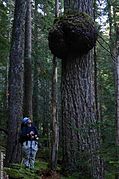
A giant burl near Solduc Falls in Olympic National Park
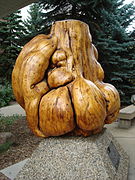
A large spruce burl on display at the University of Alberta
A longitudinal section through a larch burl from Ayrshire, Scotland
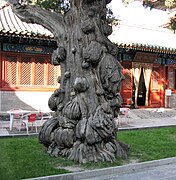
Multiple burls on an ancient cypress tree at the Beijing Temple of Confucius in China
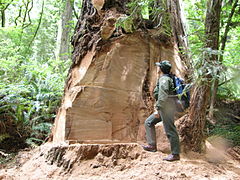
A park ranger inspects a redwood tree, vandalized to steal a burl, Redwood National Park, California

Burls on Sitka spruces, Olympia National Park, Washington, USA

Burl near Palfau,
in central Austria
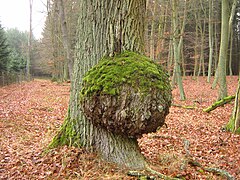
Burl on a sessile oak
(Quercus petraea)
Brohmer Bergen, Germany
See also[edit]
- Canker
- Forest pathology
- Gall
References[edit]
^ Sloane, Eric (1973). A Museum of Early American Tools. New York: Ballantine Books. pp. 28–32. .mw-parser-output cite.citationfont-style:inherit.mw-parser-output .citation qquotes:"""""""'""'".mw-parser-output .citation .cs1-lock-free abackground:url("//upload.wikimedia.org/wikipedia/commons/thumb/6/65/Lock-green.svg/9px-Lock-green.svg.png")no-repeat;background-position:right .1em center.mw-parser-output .citation .cs1-lock-limited a,.mw-parser-output .citation .cs1-lock-registration abackground:url("//upload.wikimedia.org/wikipedia/commons/thumb/d/d6/Lock-gray-alt-2.svg/9px-Lock-gray-alt-2.svg.png")no-repeat;background-position:right .1em center.mw-parser-output .citation .cs1-lock-subscription abackground:url("//upload.wikimedia.org/wikipedia/commons/thumb/a/aa/Lock-red-alt-2.svg/9px-Lock-red-alt-2.svg.png")no-repeat;background-position:right .1em center.mw-parser-output .cs1-subscription,.mw-parser-output .cs1-registrationcolor:#555.mw-parser-output .cs1-subscription span,.mw-parser-output .cs1-registration spanborder-bottom:1px dotted;cursor:help.mw-parser-output .cs1-ws-icon abackground:url("//upload.wikimedia.org/wikipedia/commons/thumb/4/4c/Wikisource-logo.svg/12px-Wikisource-logo.svg.png")no-repeat;background-position:right .1em center.mw-parser-output code.cs1-codecolor:inherit;background:inherit;border:inherit;padding:inherit.mw-parser-output .cs1-hidden-errordisplay:none;font-size:100%.mw-parser-output .cs1-visible-errorfont-size:100%.mw-parser-output .cs1-maintdisplay:none;color:#33aa33;margin-left:0.3em.mw-parser-output .cs1-subscription,.mw-parser-output .cs1-registration,.mw-parser-output .cs1-formatfont-size:95%.mw-parser-output .cs1-kern-left,.mw-parser-output .cs1-kern-wl-leftpadding-left:0.2em.mw-parser-output .cs1-kern-right,.mw-parser-output .cs1-kern-wl-rightpadding-right:0.2em
ISBN 0-486-42560-6.
^ abc Brown, Patricia Leigh (April 8, 2014). "Poachers Attack Beloved Elders of California, Its Redwoods". The New York Times.
Further reading[edit]
Corbett, Stephen (2006). The Illustrated Professional Woodworker. London: Anness Publishing. ISBN 978-0-681-22891-7.
Powers, Steven S. (2005). North American Burl Treen: Colonial & Native American. Brooklyn: S. Scott Powers Antiques. ISBN 978-0-9760635-0-6.
James, Susanne (1984). "Lignotubers and Burls: Their Structure, Function and Ecological Significance in Mediterranean Ecosystems". Botanical Review. 50 (3): 225–66. doi:10.1007/BF02862633. JSTOR 4354037.
Rankin, William Howard (1918). "Mistletoe Burl and Witches'-Broom". Manual of Tree Diseases. pp. 214–5. OCLC 1652501.
White PR (April 1958). "A Tree Tumor of Unknown Origin". Proceedings of the National Academy of Sciences of the United States of America. 44 (4): 339–44. Bibcode:1958PNAS...44..339W. doi:10.1073/pnas.44.4.339. JSTOR 89803. PMC 335423. PMID 16590202.
Zalasky, Harry (1975). "Low-temperature-induced cankers and burls in test conifers and hardwoods". Canadian Journal of Botany. 53 (21): 2526–35. doi:10.1139/b75-277.
Funk, A. (1982). "Therrya canker of spruce in British Columbia". Canadian Journal of Plant Pathology. 4 (4): 357–61. doi:10.1080/07060668209501277.
White PR, Millington WF (February 1954). "The distribution and possible importance of a woody tumor on trees of the white spruce, Picea glauca". Cancer Research. 14 (2): 128–34. PMID 13126948.
External links[edit]
- Video footage of tree burrs
Categories:
- Antiques
- Furniture
- Trees
- Wood
(window.RLQ=window.RLQ||).push(function()mw.config.set("wgPageParseReport":"limitreport":"cputime":"0.472","walltime":"0.604","ppvisitednodes":"value":983,"limit":1000000,"ppgeneratednodes":"value":0,"limit":1500000,"postexpandincludesize":"value":33729,"limit":2097152,"templateargumentsize":"value":699,"limit":2097152,"expansiondepth":"value":13,"limit":40,"expensivefunctioncount":"value":9,"limit":500,"unstrip-depth":"value":1,"limit":20,"unstrip-size":"value":28810,"limit":5000000,"entityaccesscount":"value":5,"limit":400,"timingprofile":["100.00% 520.073 1 -total"," 24.13% 125.505 1 Template:Reflist"," 21.77% 113.239 5 Template:Cite_journal"," 14.09% 73.272 1 Template:ISBN"," 11.14% 57.953 3 Template:Cite_book"," 10.57% 54.976 1 Template:More_footnotes"," 9.75% 50.710 1 Template:Catalog_lookup_link"," 9.63% 50.103 3 Template:Ambox"," 7.97% 41.474 1 Template:Cite_news"," 7.68% 39.937 1 Template:About"],"scribunto":"limitreport-timeusage":"value":"0.246","limit":"10.000","limitreport-memusage":"value":6167885,"limit":52428800,"cachereport":"origin":"mw1242","timestamp":"20190319220740","ttl":2592000,"transientcontent":false););"@context":"https://schema.org","@type":"Article","name":"Burl","url":"https://en.wikipedia.org/wiki/Burl","sameAs":"http://www.wikidata.org/entity/Q1483529","mainEntity":"http://www.wikidata.org/entity/Q1483529","author":"@type":"Organization","name":"Contributors to Wikimedia projects","publisher":"@type":"Organization","name":"Wikimedia Foundation, Inc.","logo":"@type":"ImageObject","url":"https://www.wikimedia.org/static/images/wmf-hor-googpub.png","datePublished":"2004-11-23T07:33:03Z","dateModified":"2019-03-14T21:27:31Z","image":"https://upload.wikimedia.org/wikipedia/commons/4/43/Growth_on_tree_trunk_-_geograph.org.uk_-_724687.jpg"(window.RLQ=window.RLQ||).push(function()mw.config.set("wgBackendResponseTime":110,"wgHostname":"mw1321"););



